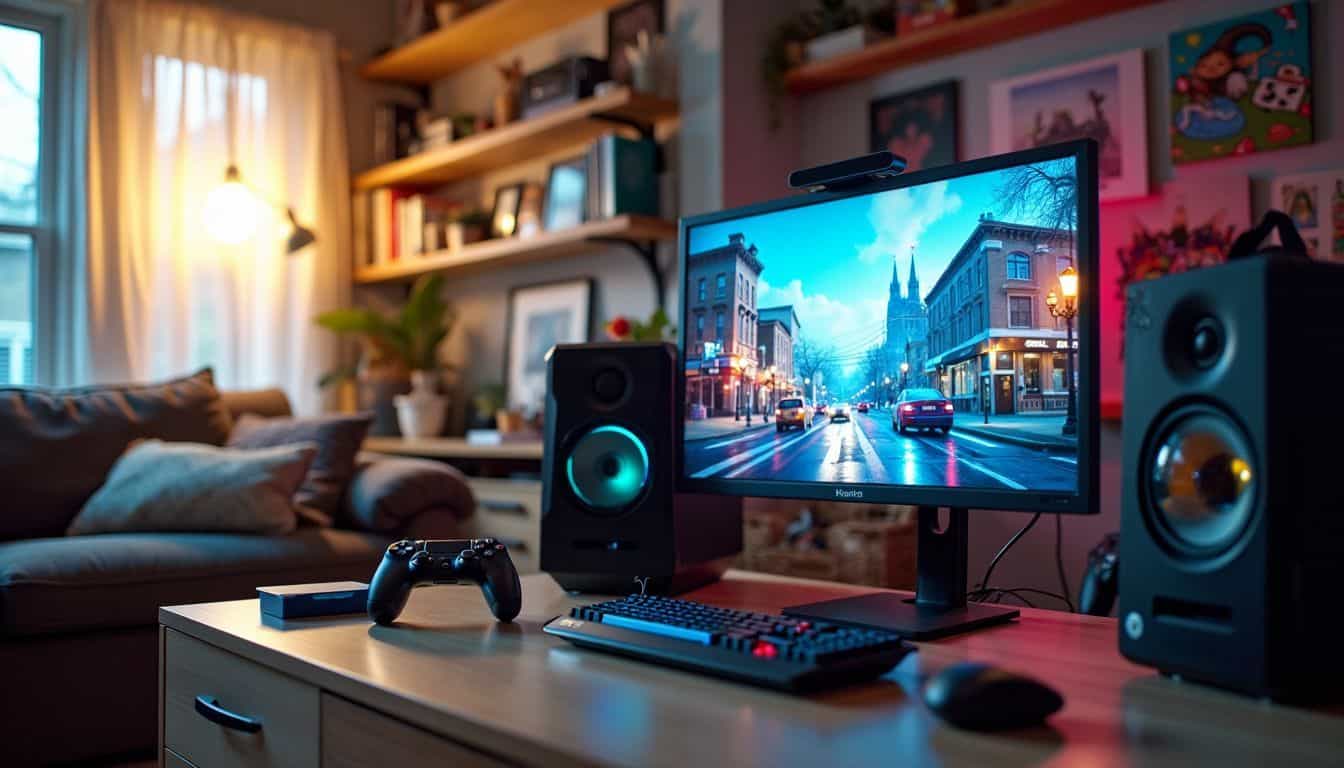Ever dreamed of making your own computer game but felt lost on where to start? Game development is a complex process that requires a mix of creativity and technical skills. This article will walk you through 8 epic steps to level up your game-making journey.
How do you make a computer game? Let’s find out!
Key Takeaways
Game development involves 8 key steps: conceptualizing, planning, choosing tools, building, testing, marketing, supporting post-launch, and expanding reach.
Popular game engines include Unity, Unreal Engine, GameMaker Studio, and Godot. Unity offers free and paid plans up to $450/month, while Unreal is free for small teams earning under $1 million yearly.
Testing is crucial – internal gameplay tests and player feedback help catch bugs and improve the game. A sample of 16,600 players gives 99% confidence in feedback data.
Marketing strategies should target the right audience. The gaming industry is worth $363 billion, so standing out is key.
Post-launch support through patches, DLC, and expansions keeps 1.47 billion gamers (projected by 2027) engaged long-term.
Table of Contents
Conceptualizing Your Computer Game

Got a game idea brewing? Awesome! Let’s turn that spark into a full-blown digital adventure. Picture your game’s core – what makes it tick, who’ll play it, and where they’ll dive in.
Identify the core idea

Let’s explore the essence of game creation – the core idea. This is where your game’s spirit comes alive. It’s like the spark that’ll ignite your whole project. What’s the main thing you want players to do? Maybe it’s solving puzzles, battling monsters, or building empires.
A good idea is like a seed. Plant it right, and it’ll grow into something amazing. – Unknown Game Developer
Your core idea sets the foundation for everything else. It’ll shape your story, gameplay, and even the look of your game. For example, if you’re making a crypto casino game, you’d focus on gambling mechanics and digital currency.
A strong core idea makes your game stand out among many options. It’s what’ll grab players and keep them coming back for more.
Select the target platform and audience

Picking your game’s home turf is key. Think about where you want your game to live – on PCs, consoles, or mobile devices. Each platform has its own perks and quirks. PCs offer power and flexibility, while mobile games can reach a huge crowd.
Consoles? They’re great for immersive gameplay. Your choice will shape how you build and market your game.
Now, let’s talk about who’ll play your game. Are you aiming for hardcore gamers or casual players? Maybe you’re after kids or adults? Knowing your audience helps you tailor everything – from graphics to gameplay.
It’s like cooking a meal for friends… you gotta know what they like! With 1.47 billion gamers worldwide by 2027, there’s a slice of the $106.8 billion US market waiting for you. Next up: drafting your game’s blueprint.
Planning Your Game Development

Planning your game is like building a roadmap. It’s where you sketch out your game’s story, decide on its rules, and figure out how players will interact with it. This step sets the stage for everything that follows – from coding to testing.
Draft a Game Design Document (GDD)

A Game Design Document (GDD) is your game’s blueprint. It’s a roadmap that guides your team through the whole process. Think of it as a master plan that spells out every detail of your game.
From core mechanics to artwork, level design to story – it’s all there in black and white.
Creating a GDD isn’t just busy work. It’s a crucial step that keeps everyone on the same page. Your artists, coders, and writers will thank you for it. Plus, it helps match your big dreams with what you can actually do.
Time, skills, cash – all these factors come into play. Once you’ve nailed down your GDD, it’s time to dive into the nitty-gritty of game mechanics and storyline.
Define game mechanics and storyline

Game mechanics are the heart of your game. They’re the rules and actions that make it tick. Think of them as the secret sauce that keeps players hooked. You’ll need to nail down how players move, fight, or solve puzzles.
For example, in a platformer, jumping and running are key mechanics. In a shooter, it’s all about aiming and firing. The storyline? That’s your game’s soul. It gives players a reason to care and keep playing.
As a video game developer, you’ll craft a tale that fits your mechanics like a glove.
I’ve found that the best games blend mechanics and story seamlessly. Take “Fortnite” – its building mechanic isn’t just fun, it’s part of the survival story. Or “Rocket League,” where the car-soccer gameplay is the story.
Your job? Make sure your mechanics and storyline work together to create an epic experience. It’s not easy, but when you get it right, it’s magic.
Choosing the Appropriate Development Tools

Picking the right tools can make or break your game. Unity, Unreal Engine, and GameMaker Studio are popular choices – each with its own perks. Your choice depends on your game type, skills, and budget.
Consider Unity software
Unity software is a top pick for game makers. It’s user-friendly and packs a punch with its tools. You can craft 2D or 3D games without breaking a sweat. Plus, it’s got a huge community ready to help when you’re stuck.
Unity offers different price plans to fit your needs. The Personal and Student versions are free – perfect for newbies or those on a tight budget. If you’re serious about game dev, the Pro plan at $185 a month might be your best bet.
For big studios, there’s the Industry plan at $450 monthly. Unity 2022.3 is the latest version you’ll need to access all the cool features.
Explore Unreal Engine
Unreal Engine packs a punch for game makers. It’s a top-notch tool that lets you craft stunning 3D worlds and lifelike characters. Epic Games, the brains behind Fortnite, created this powerhouse.
They offer it free to small teams earning under $1 million yearly. Bigger fish pay $1,850 per user each year.
Unreal’s latest version, 5.4, dropped hot off the press at GDC 2024. It’s loaded with cool new tricks for devs to play with. The engine shines in graphics, letting you build jaw-dropping scenes that’ll make players’ eyes pop.
Plus, it’s got a user-friendly interface that won’t make your head spin. Whether you’re a rookie or a pro, Unreal Engine’s got your back.
Evaluate GameMaker Studio
GameMaker Studio is a cool tool for game creation. It’s great for beginners and pros alike. You can start with the free version to test the waters. If you like it, you can upgrade to the Professional tier for $99.99.
This one-time fee gives you access to more features. For big teams, there’s an Enterprise plan at $79.99 monthly or $799.99 yearly.
One of GameMaker’s best features is its own scripting language, GML. It’s easy to learn and use. I’ve used it to make simple games in just a few hours. Here’s what a pro game dev once told me:.
GameMaker’s GML is like training wheels for coding. It gets you moving fast, but you can still do tricks with it.
Next up, let’s look at another popular game engine…
Review Godot options
Godot is a free, open-source game engine that’s gaining traction among indie devs. It’s got a ton of cool features packed in – 2D and 3D support, its own scripting language, and a user-friendly interface.
I’ve played around with it, and let me tell you, it’s pretty slick! The best part? There’s a huge community of over 500 contributors ready to help you out when you get stuck.
What sets Godot apart is its node-based system. It makes building game logic a breeze. Plus, it’s lightweight and runs on almost any device. For geeks who love to tinker, Godot’s source code is right there for you to dive into.
You can even add your own tools or tweak existing ones. It’s like a playground for game dev nerds!
Building Your Computer Game

Building your computer game is where the magic happens. You’ll bring your ideas to life with code, art, and sound. Ready to dive deeper? Let’s explore how to make your game shine!
Design game levels
Crafting game levels is where your vision comes to life. It’s not just about making pretty spaces – it’s about creating a playground for fun! You’ll sketch out your ideas, plotting where players will face challenges and find rewards.
Think of it like building a cool obstacle course. You’ll decide where to put tricky jumps, hidden treasures, and sneaky bad guys.
But here’s the kicker – levels can be static or dynamic. Static levels stay the same each time you play, like classic an indie game from the 80s.
Dynamic levels? They shake things up! They change every time, keeping players on their toes. It’s like a magic playground that’s never the same twice. So, grab your digital paintbrush and start creating worlds that’ll blow players’ minds!
Create characters and environments
Bringing your game world to life is a blast! You’ll craft cool characters and build awesome environments. First, sketch out your ideas. Then, use tools like Blender 3D or Unity to make them real.
Don’t forget to add textures and colors that pop. It’s like painting, but way cooler.
Sound matters too. Give your characters voices and your world some noise. Maybe add some epic music. Can’t do it all yourself? No sweat. You can buy ready-made assets online. It’s like shopping for your game’s wardrobe and furniture.
The goal is to make a world players want to explore.
Great game characters are like old friends – you can’t wait to see them again. – Game Dev Pro
Implement core game mechanics
Now comes the fun part – bringing your game to life! Core mechanics are the heart of your game. They’re the actions players do over and over. Think jumping in Mario or shooting in Call of Duty.
You’ll code these key moves first. Start simple. Make a basic version that works, then add bells and whistles later.
Testing is crucial here. Play your game… a lot. Is it fun? Does it feel right? Tweak until it’s just right. Don’t forget to add some juice – those little extra touches that make your game pop.
Sound effects, particle systems, screen shake – they all help make your mechanics feel awesome. Next up, we’ll look at how to fine-tune your creation through testing.
Testing and Refining Your Game

Testing your game is like finding a needle in a haystack. You’ll play it over and over, hunting for bugs and glitches. But don’t sweat it – this step’s crucial for making your game shine!
Perform internal gameplay tests
Internal gameplay tests are crucial. They help catch bugs and smooth out rough edges. Game devs play their own creation over and over. They look for glitches, balance issues, and fun factors.
It’s like being a detective in your own digital world.
These tests aren’t just about finding problems. They’re about making the game better. Devs might tweak controls, adjust difficulty, or add new features. It’s a cycle of play, fix, and improve.
This process shapes the game into something players will love.
Collect player feedback
Gathering player feedback is key to making your game awesome. You’ll want to hear from real folks who’ve played your creation. Set up surveys, forums, or in-game feedback tools to get their thoughts.
With a sample of about 16,600 players, you’ll have rock-solid data to work with. That’s enough to give you 99% confidence in your stats.
Don’t just ask if they liked it. Dig deeper. Look at how they made characters, how often they started new games, and which NPCs they talked to most. This kind of info, called telemetry data, tells you a lot about how people really play.
It’s like being a detective, but for fun! Use what you learn to make your game even better.
Make adjustments according to feedback
Feedback is gold in game dev. Players spot things you miss. They’ll tell you what’s fun and what’s not. Listen up! Fix bugs they find. Tweak controls if they’re clunky. Maybe that boss is too tough? Dial it down a notch.
Or pump up the challenge if it’s too easy. It’s all about balance.
I’ve been there. My first game? Players hated the camera. So we fixed it. They wanted more levels. We added ’em. The key? Stay flexible. Your game isn’t set in stone. It’s clay. Mold it based on what players say.
But don’t lose your vision. Find the sweet spot between your ideas and player wishes. That’s how you make a game people love to play.
Marketing Strategies for Your Computer Game

Getting the word out about your game is key. You’ll need a solid plan to grab players’ attention and keep them hooked.
Develop a comprehensive marketing plan
Creating a great marketing plan is key to your game’s success. Start by figuring out who’ll love your game most. Are they hardcore gamers? Casual players? Once you know your audience, craft messages that’ll grab their attention.
Use social media, gaming forums, and maybe even partner with popular streamers to spread the word. Don’t forget to set a budget and timeline for your marketing efforts.
Your plan should cover all bases – from eye-catching trailers to catchy taglines. Think about running contests, offering early access, or creating fun merch. Keep in mind, the gaming industry is huge – $363 billion huge! So, you need to stand out.
Be creative, be bold, and most importantly, be true to your game’s spirit. A solid marketing plan can mean the difference between a hit and a flop.
Engage with social media and gaming communities
Social media is a game-changer for connecting with players. Platforms like YouTube and Discord are gold mines for building buzz. On YouTube, you can drop trailers and team up with influencers to show off your game.
Discord lets you create chat rooms where gamers can hang out and talk about your creation. It’s like having a virtual clubhouse for your biggest fans!
Don’t forget other social spots too. Share cool screenshots on Instagram or post quick gameplay clips on TikTok. The key is to be where your players are. Talk to them, listen to their ideas, and get them excited about your game.
Building a strong community can turn casual players into die-hard fans who’ll spread the word about your awesome game.
Organize launch events
Launch events can make or break your game’s success. They’re not just parties – they’re your chance to shine! A room full of gamers, journalists, and industry leaders all eager to try your creation…
It’s your moment to show off what you’ve built and get people talking. I’ve seen firsthand how a well-planned event can create buzz that lasts for weeks.
But here’s the trick – you gotta make it memorable. Maybe set up gaming stations where folks can play demo levels. Or go all out with themed decorations that match your game’s world.
Food, drinks, and swag are must-haves too. Don’t forget to livestream the event for fans who can’t be there in person. Trust me, an amazing launch event can turn your game from a blip on the radar to the talk of the town.
Supporting Your Game Post-Launch

After launch, your game needs love. Fix bugs, add cool stuff, and talk to players. Ready to level up your game-making skills? Keep reading!
Monitor and resolve game issues
Game issues can pop up like pesky bugs. You need to keep an eye out and squash them fast. Set up ways to track problems players face. Use tools to spot crashes, glitches, or lag. Fix these quick to keep gamers happy.
It’s like being a doctor for your game – diagnose and treat!
Don’t forget about balance issues too. Watch how players use different characters or items. If something’s too strong or weak, tweak it. This keeps the game fair and fun. Next up, let’s talk about keeping your game fresh with updates and improvements.
Update with patches and improvements
After fixing bugs, it’s time to polish your game. Patches and updates keep your creation fresh and exciting. They fix lingering issues and add new content. Players love games that grow and change over time.
Think of patches as tune-ups for your digital ride. They smooth out rough edges and boost performance. New features can breathe life into older games. Maybe you’ll add a cool character or a tricky level.
The Epic Games launcher makes updates easy. Just click the three dots by your game’s name to check for new files. Turn on auto-updates, and you’re all set!
Deliver consistent customer support
Customer support can make or break your game. Players need help fast when they run into problems. Set up a good system to handle issues quickly. Use tools like Discord or a help desk to answer questions.
Train your team to be friendly and quick. Happy gamers spread the word, so treat each one well.
Pay attention to common problems. Fix bugs quickly and release patches. Regular updates show you care about how players enjoy the game. This builds trust and keeps folks coming back for more.
Good support isn’t just fixing things – it’s about making players feel heard and valued.
Expanding the Reach of Your Game

You’ve launched your game – now what? Think bigger! Your game’s journey is just starting. There’s a whole world of ways to grow your creation and keep players hooked.
Plan for downloadable content (DLC)
DLC is the secret sauce that keeps gamers hooked. It’s like adding extra toppings to your favorite pizza – more fun, more flavor. As a game dev, you’ll want to cook up some tasty DLC plans early on.
Think new levels, cool characters, or fresh storylines. But here’s the kicker: you gotta keep your players happy long after launch.
I’ve seen firsthand how DLC can breathe new life into a game. It’s not just about making more cash – it’s about building a community. You’ll need to crunch some numbers, chat with your fans, and maybe even hire a data whiz.
Trust me, it’s worth it. Good DLC can turn your one-hit wonder into a chart-topping franchise.
Consider opportunities for a sequel or expansions
Game sequels and expansions can be gold mines. They let you build on your success and keep fans hooked. Think about new storylines, characters, or gameplay features you could add. Maybe your runner game could get new levels set in space, or your RPG could explore a whole new continent.
With 1.47 billion gamers expected by 2027, there’s a huge market for more content.
Expansions are a great way to test new ideas without the full risk of a new game. You can try out fresh mechanics or art styles. If they work, awesome! If not, no biggie – your main game is still intact.
Plus, expansions can boost your game’s replay value. That’s key in today’s $363 billion gaming market where players always want more bang for their buck.
People Also Ask
What skills do I need to make a computer game?
You’ll want a mix of talents. Programming know-how is key. Learn languages like C++ or Python. Graphic design skills help too. Use tools like Adobe Photoshop or Inkscape for art. Don’t forget about sound. Digital audio workstations are great for music and effects.
Which game engines are good for beginners?
Unity 3D is a top pick. It’s user-friendly and works on many platforms. Unreal Engine is another solid choice. Both have marketplaces for assets. Buildbox is great if you want to make an endless runner game. Scratch is perfect for total newbies.
How important is user experience in game development?
It’s crucial! Good UX design can make or break your game. Focus on smooth gameplay mechanics and intuitive user interfaces. Test your game often. Get feedback from game testers. Remember, happy players come back for more.
Can I make money from my computer game?
Absolutely! There are lots of ways to cash in. Sell your game on platforms like Steam or Google Play. Try in-app purchases for extra content. Use social media marketing to spread the word. Facebook and other social platforms can help you reach more players.
How long does it take to make a computer game?
It varies wildly. A simple game might take a few weeks. Big projects can take years. Break your work into chunks. Make prototypes to test ideas. Set realistic goals. Remember, Rome wasn’t built in a day!
Do I need to work alone, or can I join a team?
Both options work! Solo dev gives you full control. But teamwork can be fun and productive. Look for game jams or online communities. You might find artists, programmers, or marketers to team up with. Some organizations offer mentorship too. The choice is yours!
